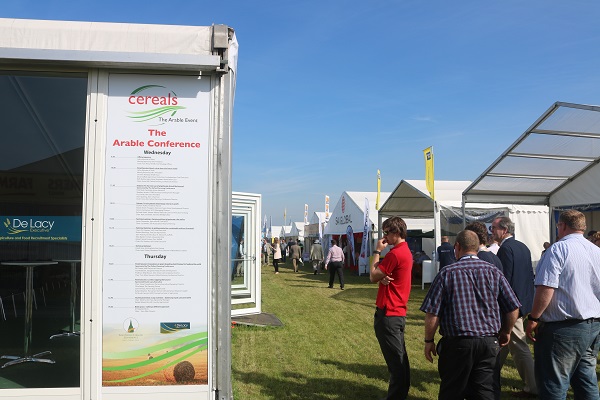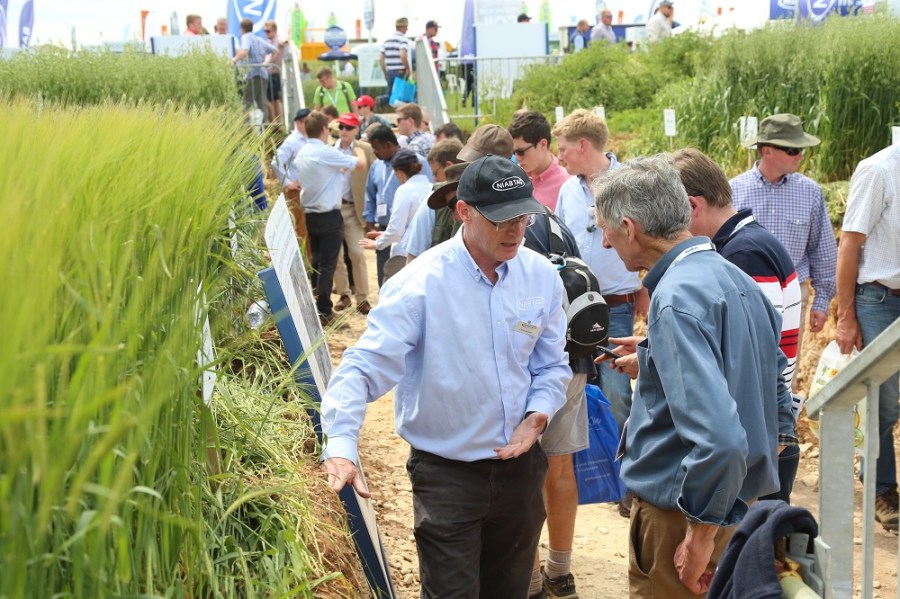Expect to see quite a few changes at Cereals this year, with no AHDB Recommended List plot tours, but other features introduced to showcase what’s new in the industry. CPM scans the highlights.
We want a visit to Cereals to be inspiring from start to finish.
By Charlotte Cunningham
[table id=6 /]Cereals 2018 is all about change. From the structure of the event itself to preparing businesses for changes ahead of Brexit, there’s an abundance of new features and advice at this year’s event, say organiser Comexposium.
Driving the change is feedback from the farmer and exhibitor advisory boards which were formed at the end of last year. Cambs farmer, Ralph Parker, has been attending the event for over 20 years and says getting growers involved is a very sensible option. “It’s essential that farmers have an input because the show is for them. The better the show is, the better it is for farmers.”
Among the changes being introduced at this year’s event is a revamp of the Arable Conference. This year it’ll be taking a new form – splitting into two seminar areas: Cereals Controversial and Cereals Conversations.

Cereals Controversial and Cereals Conversations takes the place of the Arable Conference.
Cereals Controversial – fronted by panels of politicians and leading industry officials – will be a hub for discussion of the hottest topics in the industry. Visitors can expect to hear debates on topics such as business resilience, the future of the supply chain with no subsidies, increasing farm business productivity, and benchmarking to measure success.
Over in the Cereals Conversations marquee, talks will take a more technical approach, arming visitors with the latest in-depth scientific knowledge and research. Hot topics to be covered include sustainable soil health and nutrition, artificial intelligence, guarding glyphosate, and emerging weed control strategies.
Knowledge exchange opportunities continue with new, guided tours, led by industry professionals. Expert guides will take groups of visitors on a curated tour of exhibitors and event features relating to specific themes – covering everything from Recommended List varieties to soil management and innovation in action. Additional BASIS and NRoSO CPD will be available from a range of exhibitors across the site.
Based on visitor feedback, innovation will be at the forefront of visitor experience, with new Innovation Zones at both entrances. “We want a visit to Cereals to be inspiring from start to finish – not just while looking around exhibitor stands,” says Jon Day, event director. “Therefore, some of the latest arable innovations will be previewed at the main entrances – giving farmers a flavour of what they can expect to see and hear during the day.”
Robotic technology
As automation and robotic technology is likely to play an important role in the future, this year’s event will feature the UK’s only live demonstration of Harper Adams’ Hands Free Hectare (HFH) equipment outside of the university.
Last year, Harper Adams University and Precision Decisions set out to be the first in the world to drill, tend and harvest a crop without operators on the machines and agronomists in the field with the HFH project. After a successful harvest, and gaining funding from AHDB, the project has returned for a second year.
Project lead Kit Franklin explains: “In Nov 2017 we successfully drilled our second crop, a hectare of winter wheat, with the ISEKI TLE 3400 tractor and Simtech drill which we used in the first round of the project; but this time with improved accuracy.
“The 38hp tractor, which has been integrated with a drone autopilot, was originally selected due to its hydrostatic transmission, which makes it highly controllable for automation purposes. To operate what would usually be hand and foot controls, we’ve used electronic linear actuators as might be found in a combine for sieve adjustment.”
UK-based firm, Garford Farm Machinery, is also embracing robotic technology with its Robocrop InRow weeder. For use on a variety of crops including brassicas, sugar beet and lettuces, the kit uses a digital video camera to capture images of the crop ahead of the tool bar. These images are then processed and analysed to find the position of the individual plant to enable lateral steering of the hoe and individual synchronisation of the InRow weeder discs.
Speeds depend on cropping and plant spacing – with a minimum spacing of 15cm required for the machine to be worthwhile – however, users can expect to achieve 2-8km/h.
Drone developments
In recent years there have been rapid developments in drone technology and processing software. Drones can now measure a range of crop parameters such as establishment, biomass and presence of weeds and diseases as well as plant counts, amassing data from large areas in a matter of minutes.
Agrovista will be back at this year’s event, discussing the role drones can play. “Flying a field with a near-infra-red camera, for example, highlights variations in the crop canopy,” explains Jack Harris at Agrovista. “We can then overlay other information based on yield maps, soil tests and scans to build a variable rate nutrient map.”
Grassweeds can be identified using a standard visual camera and can be plotted onto maps to identify which areas need overall, spot or no treatment, he adds.
Drones are also being used to spot diseases early and are finding a valuable role in potato crops. Agronomists can zoom cameras in on individual plants, helping them identify potential problems such as blight, rhizoctonia and blackleg earlier than from the ground. “We can also identify other signs of stress, such as PCN effects, and those caused by soil and drainage problems.”
Farm software
The need for greater efficiency is driving data collection throughout the industry. Whether it’s on a small or large scale, it can shape agronomic and other business decisions.
While farmers have been collecting data for years, digital technology is revolutionising – and simplifying – the way it’s done.
Pear Agri is currently developing a new cloud-based crop recording software which will be on display at this year’s event. The software follows on from the firm’s existing programme and will offer a cost effective, simple data recording solution – with the added benefit of being cloud based, explains Charlie Farrington at Pear Agri. “The programme will be available in three formats for use by farmers, agronomists and contractors. Being cloud based, everyone will be able to see the latest relevant information as it’s being updated.
“When the agronomist creates a spray recommendation, the farm and contractor will be notified of a new task to complete. Or when a contractor completes a job, using the app in the field, they can record the work they’ve done. Depending on the hours or hectares worked, it’ll calculate the cost and will automatically notify the farmer of the completed work as well as sending an invoice.”
Available via a web version, desktop, mobile and tablet app, the programme also offers machinery costings to calculate operation expenditure, as well as financial and assurance reports – including year-end valuation and gross margins. In addition, users will benefit from access to the LIAISON pesticide database to ensure compliance, and a fertiliser planner module based on the RB209 guide.
Landmark’s Geofolia will also be debuting new features based on user feedback at this year’s event, including Import Invoice from KEYPrime Accounts, Agronomists Import and extended reporting to include traceability and costings. “We were being asked by farmers to provide recording to cover crop assurance, stock records, costings and mapping all in one place, avoiding the need for multiple spreadsheets,” says Keith Morris at Landmark. “The cloud and mobile app option aids manager and operator alike.”
John Deere’s latest offering – FarmSight – will also be on display. The software is designed to increase productivity and reduce costs, especially when paired with other precision farming systems like automatic steering and section control for sprayers and spreaders.
“The effective utilisation of real time data and the provision of a wireless connection between the farm office and machinery operators lead to more efficient performance, higher outputs and lower operating costs,” explains marketing manager Chris Wiltshire.
With the JDLink telematics system the remote display access, wireless data transfer (WDT) and mobile data transfer are available to connect all makes of machine and ISOBUS implements to the customer’s Operations Centre in the MyJohnDeere.com portal. “WDT allows two-way exchange of set-up files, prescription maps and documentation data between the office and the machine in the field,” he adds. “It automates data transfer and reduces the risk of losing information.”
And it’s not just data recording where software plays a crucial role. Precision farming tools are playing an increasing role in measuring soil health and influencing soil management decisions, says Lewis McKerrow at Agrovista. “Parameters such as pH, organic matter levels, electro-conductivity (to ascertain soil type) and topography need to be measured accurately to ensure appropriate fertility management strategies. Agrovista uses a Veris U3 to measure all the above parameters quickly and accurately in one pass of a field.”
It can be towed by a 4×4, ATV or tractor at up to 16kph in 12m bouts, delivering rapid on-the-go soil scanning, he explains. “The data highlights soil variability and can be overlaid with yield maps, field scans and nutrient tests to assess the limiting factors of those soils. This provides a record of the soil’s health and can be used to target variable rate applications and organic manures.”
Advanced zoning tools also highlight likely nitrogen leaching, nutrient lock up and water retention areas, further aiding management decisions.
Plots and pits
Alongside the new features and launches, there’ll be the return of some of the other aspects of Cereals that are proving popular.
With soil high on the agenda, the 20m long x 1.5m deep Soil Pit will demonstrate the impact of different cropping options on soil structure. This year’s crops include a mixture of both winter and spring options, such as beans, wheat and oats, as well as cover crops like radish and vetch.
This year, there’ll be no Recommended List crop plots nor variety tours hosted by AHDB, which will instead be focusing on preparing businesses for the changes that lie ahead. But there will be arable plots, profiling everything from market-leading varieties to up-and-coming genetics. In addition, growers can compare untreated and treated trial plots, helping them identify the most resistant options.
NIAB, however, is retaining its crop plots and will showcase 40 winter wheat and 27 winter oilseed rape varieties – either already established on the AHDB 2018/19 Recommended List or candidates – with more demonstration plots this year than ever before. The untreated plots will give visitors a head start in their variety selection for next season, with independent specialists on hand to point growers in the right direction.
Independent seed specialist, Senova, will be showcasing its winter wheat variety Costello, which continues to increase in popularity after another good harvest performance in 2017.
Syngenta is set to unveil two new winter wheat varieties – SY Medea and Gleam – while RAGT will also be showcasing the latest addition to its wheat profile, Gravity. Five leading Hyvido barley varieties will be on display, including two of its newest varieties, Belmont and Libra.
RGT Asteroid – from RAGT – will also be found in the barley plots. Recently added to the 2018/19 Recommended List as a malt and grain distilling variety under test, it looks to be particularly well suited to the Scottish distilling market.
In the oilseed plots, Elsoms latest offering – Kielder – will be on show. Particularly valuable for growers in the North, Kielder boasts excellent vigour and a good defence against cabbage stem flea beetle, as well as a score of 7 for light leaf spot resistance.
A number of specialist and alternative crops will also be found among the crop plots from leading firms including Premium Crops and Soya UK




